Fresh talent expanding horizons
Fresh talent expanding horizons McGill University
User Tools (skip):
Fresh talent expanding horizons
Among the other novelties of autumn on the McGill campus this year, more than 80 new faculty members from around the world walk among us, pondering the difference between a latte and a double-double or wondering whether February could possibly be as bad as they say (we won't spoil it for you). Every year, the Reporter profiles a sampling of these new professors to offer just a glimpse of the best and the brightest.
Desmond Tsang
The balance of numbers
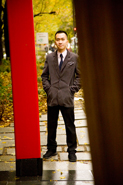
Desmond Tsang, Desautels Faculty of Management, says accounting is a societal function.
Claudio Calligaris
Feng shui, the Chinese tradition of arranging objects in a harmonious way, means "wind and water." The term is said to come from the ancient poem, "The winds are wild, The sun is warm, The water is clear, The trees are lush." Add to that "The books are balanced."
Sitting in his Bronfman Building office, Accounting Prof. Desmond Tsang is very much the grown up, University of California at Berkeley-PhD-holding version of the boy who took Feng shui lessons in his native Hong Kong before moving to Toronto at age 15.
Ask him what makes accounting important and his answer is quick, heartfelt and rooted in the pursuit of harmony: "In a society, different people have different functions. We all need accountants so we can have a properly functioning society. You need good bookkeepers to run the books so things go smoothly for everybody." So, like Feng shui, accounting is about balance? "Absolutely."
When he's not teaching his 170 students, Prof. Tsang puts balance into his own life by enjoying his new 42-inch LCD screen television. "It's good to be hard-working," he says with a smile, "but one has to have a balanced life. For me, that means relaxing after work by watching TV."
Just about the only area in which Prof. Tsang suspends his love of equilibrium is in his esteem for his students. "I'm not just saying this because you're writing down what I'm saying," he assures a reporter, "I mean it from the bottom of my heart. I have taught in Berkeley and at U of T and I'm very impressed with my Desautels students. They're both talented and hardworking." And that, for Desmond Tsang, who finds satisfaction and joy in his new job at the Desautels Faculty of Management, is the perfect balance.
—Katherine Haralambous
Grace Marquis
Work to be done
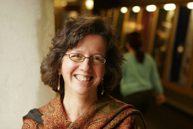
Grace Marquis looked around Lima and what she saw changed her life. Her research now focuses on improving nutrition for the poor.
Owen Egan
A funny thing happened to Grace Marquis after getting her BA in Spanish Languages and Literature from Indiana University; ella cambió caballos en el centro de la corriente. Translation: she changed horses in mid-stream.
Living in Lima, Peru for a year during a study abroad program, Marquis witnessed first hand the yawning economic gap that separates the very rich from the very poor. Homeless people squatted in abandoned buildings within the old colonial city's historic downtown core and just outside city limits, sprawling shantytowns butted up against the harsh desert. "It wasn't a sudden epiphany," says the Canada Research Chair in Social and Environmental Aspects of Nutrition. "It was the gradual appreciation that there was work to be done here."
And work she did. Returning to Lima with a MSc in Human Nutrition, Marquis began a seven-year stint at the Nutrition Research Institute, where she worked primarily with mothers breastfeeding their babies. "The challenge for many low-income communities is to maintain exclusive breastfeeding for the first six months so that children will not be exposed to pathogens and become sick," she explains. "The second challenge is to find a high-quality complimentary food that will allow babies to continue to grow adequately."
Today, although Lima is some 6,000 kilometers away from Marquis' office in the School of Dietetics and Nutrition, the city is still very close to her heart. At present, Marquis is spearheading an ongoing study that looks at birth outcomes, risk of low birth weight, pre-maturity and prolonged labour for women who either breastfed older children throughout their pregnancies or didn't. Researchers are also trying to see if zinc-deficiency — a common problem among Lima's shantytown women — can be linked to poor birth outcomes.
But Marquis has also expanded her horizons significantly, as she is heading a pair of studies ongoing in Ghana, including a project to improve pre-school children's diets through increasing their access to animal products and educating mothers on their children's nutritional needs.
Back in Montreal, Marquis relies on her extensive fieldwork to give her classes concrete examples of some of the day's most pressing nutritional issues. "It's wonderful to be able to work with such bright and energetic students," says Marquis. "Many of them are getting ready to go out into the field for the first time and you can see how excited they are." Almost as excited as a young Spanish student poised to cambiar caballos.
—Neale McDevitt
Yaëll Emerich
Hot property
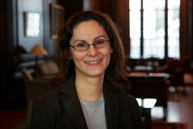
Yaëll Emerich, who left Paris for Quebec six years ago, is a respected expert in property law.
Owen Egan
In civil property law, the idea of owning things is firmly established. But, unlike in common law, in civil law the notion that you can own something invisible, like an idea or a debt, still meets with resistance. It's an issue Yaëll Emerich, a newly-hired professor in McGill's faculty of law and an expert in property law, has devoted serious attention to.
"I evaluated all the arguments against admitting that property can bear on something other than the corporal [in civil law]," Emerich says, describing her recently-defended doctoral thesis on civil property law in Quebec, where she has lived for six years, and in her native France as well. Although some of these arguments for the status quo are well-founded, she says, they're in need of reevaluation.
Emerich's work has not gone unappreciated: her thesis won both the Prix Minerve and the Prix de l'Association des professeurs du droit du Québec and in November it will be published by the prestigious Paris-based Librairie Générale de Droit et de Jurisprudence (LGDJ). As a student, to have a work published by LGDJ "was one of my dreams," she says, flashing a broad smile. She adds that she's also very excited about the work's upcoming publication by Éditions Yvon Blais here in Quebec.
Born and raised in Paris, Emerich began her study of law in the City of Lights before relocating in the mid-nineties to Lyon, where she worked on a PhD under the supervision of renowned legal scholar Frédéric Zénati.
It was Zénati's recommendation, combined with her desire to experience life in a foreign country, that sent her to McGill, she says. "It was [the McGill-based] Quebec Research Centre for Private and Comparative Law (QRCPCL) that brought me here," she says, explaining that her academic mentor first suggested she look into joining the centre.
Since arriving in Quebec, Emerich has done doctoral work at l'Université de Montréal and postdoctoral studies here at McGill. She has also put her expertise in jurilinguistics to use over the past four years as a member of the editorial committee of the QRCPCL's Private Law Dictionary.
—Michael Murphy
Mick Sullivan
Rock's loss
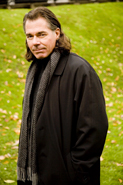
Mick Sullivan, Department of Psychology, explores the physical toll of catastrophic thinking.
Claudio Calligaris
When asked how he wound up among the professorial newcomers at McGill, psychologist Mick Sullivan shrugs sheepishly. "I actually put university on hold for a bit way back when I was going to be a rock star," he says with a grin. "That I'm back suggests that it was not the most successful venture of all-time."
After realizing that the musical career wasn't going to pan out as he had hoped, Sullivan traded the hedonistic pleasures of rock for the monastic pain of research. Well, the research of pain actually.
It was during his internship in the pain unit of an Ottawa-area rehabilitation centre that the affable Sullivan found his calling. "It fascinated me how two people with pretty similar injuries and no discernable medical differences could react so differently to pain — one would recover over a set period of time while the other wouldn't make any progress at all."
Sullivan began delving into the world of catastrophic thinking. Essentially, castastrophizers have an alarmist reaction to pain in which they are convinced that they have torn a muscle or developed a tumour. "Once they start focusing all their attention onto their affliction, they unleash a cascade of events that amplifies the way their brain processes pain," says Sullivan.
Recent brain imaging studies suggest that the brains of catastrophizers light up differently than non-catastrophizers, meaning that what started off as a psychological factor might actually become a physiological factor. But with each question that gets answered, five more pop up. "We're still looking at how we acquire catastrophic thinking," says Sullivan. "Is it something we learn from our parents or are we hard-wired for it straight from birth?"
Because catastrophic thinking is considered the most significant psychological factor contributing to persistent pain and disability, Sullivan is also actively involved in a group that trains frontline rehab professionals how to identify its symptoms and treat the condition. "By training specialists to intervene early, we will be able to alleviate the pain before it comes chronic."
—Neale McDevitt
Thomas Szkopek
Tracking electrons
If you were able to count the transistors on a square-centimeter chip in your computer, you'd find almost a billion of the tiny on-off switches — each one so small that a mere thousand electrons, more or less, are enough to flip that switch. And the shrinkage continues. "Industry is continually packing more components onto chips, so that by 2020, we may have as few as ten electrons switching transistors on and off," says Thomas Szkopek. "And when we make devices that small, we run into quantum mechanical and other physical phenomena that don't appear in larger devices." Szkopek, a specialist in nano-electronics and nano-devices, joined the Department of Electrical and Computer Engineering in September, fresh from his doctoral studies at UCLA; he completed his previous degrees at the University of Toronto. "Rather than looking at these new quantum phenomena as a detriment, we should be finding ways to take advantage of them," he says. Szkopek is setting up a research lab where he will develop systems with nano-scale transistors in order to track single photons, enabling us to learn a bit more about how to turn quantum mechanics to our computing advantage. He will also be exploring the possibilities of using organic frameworks, such as DNA, to support crystals that could be used in the sorts of systems you find on a computer chip.
Szkopek was attracted by McGill's commitment to nanoscience, an area where the university's research body has grown exponentially in recent years. "This kind of work requires the cooperative efforts of people who understand chemical synthesis, physics and electrical engineering, so I expect to have lots of collaborations with people in the Physics and Chemistry departments," he says. "And, after living in Los Angeles for so long, it's great to be back in a city where you can actually walk around."
—Patrick McDonagh
Myriam Denov
Chance meetings
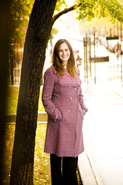
Myriam Denov's latest research focuses on the Lost Boys and Girls of Sudan, a group of young refugees who walked all the way from their war-ridden country to relief camps in Ethiopia and Kenya.
Claudio Calligaris
Serendipity has impeccable timing for Myriam Denov. When one of her research projects wraps up, she always stumbles on a new outlet for her spirited curiosity. That's why this social work professor doesn't like playing guessing games when it comes to her future.
"My hope is to continue to contribute to the multidisciplinary fields of children's rights, war and political violence, and peace building," says the Toronto native, who joined McGill in September.
Denov is especially passionate about the plight of war-affected children. She recently completed a three-year project on child soldiers who fought in Sierra Leone's Revolutionary United Front during the country's decade-long civil war. With the support of the Canadian International Development Agency, she conducted in-depth fieldwork in Sierra Leone, interviewing 80 boys and girls to gauge their experiences during and following armed conflict. What she discovered was unsettling.
"When the children returned home, they were stigmatized and rejected by their families and communities, despite the fact that many had been forcibly abducted into armed conflict," she explains. To support their reintegration into civilian life, Denov encouraged the children to actively participate in the research process as co-researchers.
Clearly, Denov inspires trust in the children she works with. At the Children's Rights and International Development Conference that she organized in Ottawa in June 2006, members of the Lost Boys and Girls of Sudan came to her asking for help. Displaced during the Sudanese Civil War, and arriving in Canada alone with few systems of support, these refugee youth now struggle with homework, part-time jobs and discrimination in their new Winnipeg and Calgary homes. Denov instantly sympathized with their situation, making their experiences in Canada the focus of her newest research project on the realities of unaccompanied minors.
"That's the beauty of social work—it can encompass a myriad of research topics," says Denov, who can't wait to collaborate with the School of Social Work's affiliate institutions, like the Centre for Research on Children and Families.
As for the beauty of her new city, Denov is equally thrilled. "Montreal is a culturally and linguistically diverse city, which is very important to me," says the former classical ballet dancer. "There's so much to do here and I can't wait to take advantage of that!"
—Natalie Fletcher
Shirley Steinberg
In the crosshairs
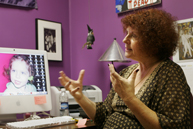
Shirley Steinberg, Faculty of Education, is deconstructing the whitewashed truths of our culture.
Owen Egan
Poor Barbie. For years Toydom's reigning glam queen has been subject to the periodic railings of feminists who bellow that her sublime hip-to-waist-to-bust ratio plants a dangerous seed of self-loathing in the minds of little girls. If that weren't tough enough, Shirley Steinberg just blew into town.
"The feminist perspective on Barbie is too obvious," says the faculty of education's newest professor of cultural studies. "Many Barbies now come with little books that, for example, claim to tell the ‘true story' about Native Americans or the Pilgrims. Of course, if you deconstruct the text, you quickly realize that this is a whitewashed, rightwing version of the truth that our children are digesting and retelling. That's a little disturbing." Sometimes, it appears, a toy is not just a toy.
Steinberg comes to us from Brooklyn College of the City University of New York and from the school of critical theory that exposes the images of power embedded in cultural subtext. Be it a hit sitcom, a glossy magazine, a TV newscast or a rap video, this media expert wants to know who produced it, why it is being produced and what ideology motivates its production. "Just look at movies," she says. "The ideology influences everything from the language being used to the score. Even the camera angles — they all are chosen with a political agenda in mind."
The native of L.A. points to Risky Business, an early Tom Cruise vehicle, as a perfect case in point. "I started my dissertation looking at privileged white boys in the media," she says. "In this movie, Tom Cruise runs a whorehouse from his parent's house and still gets to go to Princeton. Men of colour could not do that, women could not do that, gays and lesbians could not do that — they'd all get punished."
If this sounds like a non-too-subtle dig at the American right buckle up, Steinberg is just rolling up her sleeves. "George W. Bush is the personification of this type of privileged white man. He's not too smart, he's rich, he's running the show and all the while there's that I'm-getting-away-with-it-attitude."
Not surprisingly, Steinberg and husband Joe Kincheloe (another new Education professor), are looking to lay down some roots here. "I've always been a Canadian wannabe," she laughs. "I know [rock bands] Trooper and Chilliwack." Ah, there's culture and then there's good taste.
—Neale McDevitt
Michael Reed
Demystifying disease
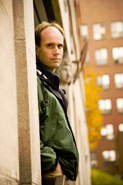
Michael Reed, Faculty of Medicine, is fascinated by the mysteries of tuberculosis.
Claudio Calligaris
For Michael Reed, science started as a family affair. When the Australian-born doctor chose to study biochemistry and microbiology as an undergraduate, he was delighted to be following in the footsteps of his father, who was also a scientist. Once in university, though, his ambition came into a life of its own, leading him to doctoral and post-doctoral research on agricultural parasites like liver fluke and infections like malaria. Now a fresh face on McGill's team of medical experts, Reed has his sights set on deconstructing tuberculosis.
"I've always been fascinated by diseases — all through university and since then," he says. My current research involves discovering how various strains of tuberculosis have evolved different strategies to cause disease."
Reed's fascination with tuberculosis places him in a complex web of history that is as lethal as it is lengthy. The disease is at least as ancient as the 5,000-year-old Egyptian mummies whose excavated remains show traces of it. For centuries, tuberculosis has boggled scientists, taking countless victims along the way—from poor city-dwellers to great artists like Chopin and Orwell. Today, the World Health Organization estimates that the disease kills two million annually, a statistic all the more threatening to those whose immune systems are already weakened by HIV/AIDS. The difficulty, as Reed underlines, is that Mycobacterium tuberculosis, the bacteria that causes T.B., develops at a very slow rate, meaning there's no shortcut to demystifying its intricacies.
Luckily for Reed's inner drive, McGill is the ideal place to start. Armed with leading epidemiologists, geneticists and the Centre for the Study of Host Resistance, the university has all the resources necessary to remain at the forefront of tuberculosis research. Plus, through his classes and research, Reed is in constant contact with lively, enthusiastic students, something he missed while working at the National Institutes of Health in Washington, DC.
What does Reed find not so ideal about working in Canada?
"The cold."
What can our True North Strong and Free do to make it up to him?
"Well I love fishing, and Canada is great for that."
While there's no place like sunny Melbourne, with the many research opportunities McGill has to offer on infectious diseases, we're willing to bet Reed won't be a fair-weather friend.
—Natalie Fletcher
Brad Siwick
Lights, camera, diffraction!
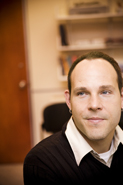
Brad Siwick, chemistry and physics, has a passion to film what has never been filmed.
Claudio Calligaris
For a guy who wants to make films, Brad Siwick has some pretty weird ideas about success. He has no Oscar aspirations and doesn't seem to care one iota about the fickle thumb of Roger Ebert. In fact, if the world is but a stage, Siwick wants to occupy only the smallest part of it.
The Canada Research Chair in Ultrafast Science, Siwick wants to film the unfilmable world of molecular change. "Throughout the 20th century, an enormous effort has been made to develop techniques for determining the atomic structure of matter, with the most famous being x-ray diffraction, which was used to discover the double helix structure of DNA," explains Siwick. "The problem is that all of these techniques can only be applied to matter that is static. The real magic of chemistry or biology is in the dynamics when something changes from one thing to another."
One of the main hurdles is the fact that, on top of being incredibly small, atoms move extremely fast when undergoing change. Atomic rearrangements inside a molecule can take place in tens of femtoseconds (one millionth of a nanosecond), with a femtosecond being to a second what a second is to the age of the dinosaur. No device has ever been developed that can capture this Holy Grail of chemical reactions. Not yet, anyhow.
Working with a group of Danish physicists who design particle accelerators of atom-smashing fame, Siwick has drawn up the plans for a molecular movie camera — the first of its kind in the world. Using specialized femtosecond lasers, a very sophisticated strobe, Siwick will initiate chemical reaction in the material under observation. A modified transmission electron microscope will then zap the material with a short burst of electrons as it is undergoing alteration. The diffraction pattern produced (how the electrons bounce off the material in motion) is a snapshot of the atoms at a specific moment during their rearrangement. A series of such snapshots, when run together, will create a movie much like an old-fashioned flip book.
When asked what drives him in his pursuit, Siwick smiles. "This is really fundamental science. I want to learn fundamental things about the world that weren't known before," he says. "I have no doubt that great science will come out of this."
If, in fact, God is in the details, it sounds like Sewick has found his paradise.
—Neale McDevitt

